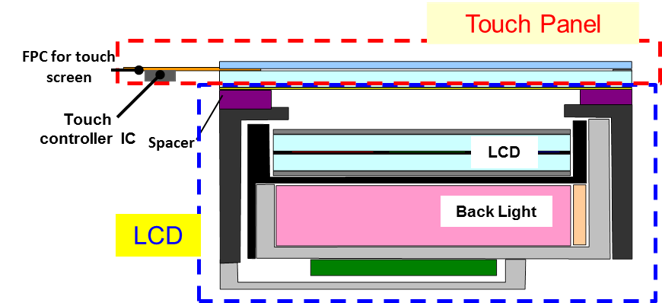"On-Cell Touch" Technology
Kyocera's "On-Cell Touch" (OCT) technology will have the Projected Capacitive (PCAP) touch sensor layer built into the LCD structure. With this integrated structure, the touch functionality is embedded within the display itself rather than a separate touch screen component on top of the display.
By adding a fractional amount of thickness to the LCD module Kyocera eliminates a full touch screen panel over the display surface, resulting in a thin and lightweight structure. Additionally, by eliminating a touch substrate layer, it eliminates interior optical reflections and improves visibility.
The touch controller is mounted on the display Printed Circuit Board (PCB), allowing the PCAP cable to be shielded inside the module (Fig. 2). This dramatically reduces the noise that could be picked up by the touch screen Flex Printed Cable (FPC) in a conventional touch panel configuration (Fig. 1).
TFT-LCDs with Advanced Wide View technology are well suited for graphic designs, medical applications, automotive clusters, center stack consoles, and other applications that require accurate and consistent color reproduction with super wide viewing angles.
| Fig. 1: Conventional touch panel Configuration | Fig. 2: On-Cell Touch technology |
On-Cell Touch technology also reduces the cost and simplifies the supply chain by eliminating the need for a separate PCAP sensor and assembly and test requirements of current solutions.
Kyocera is able to offer a total solution to its customers by combing a best-in-class TFT LCD with the most advanced PCAP touch technology.
Features:
- Thin and lightweight structure
- Eliminates interior reflections
- Excellent visibility
- Simple integration
- Super noise resistance
KDA-070OB-18053S-A
- Diagonal Size: 7.0"
- Brightness: 500
- Display Mode: Normally Black IPS
- Resolution: 800XRGBX480
- Interface: LVDS
- Temperature: Normal
TCG070WVLSJPPA-GD20
- Diagonal Size: 7.0"
- Brightness: 500
- Display Mode: Normally Black
- Resolution: 800x480
- Interface: LVDS
- Temperature: Medium Extended Temperature
TCG070WVLSJPPB-GA20
- Diagonal Size: 7.0"
- Brightness: 500
- Display Mode: Normally Black
- Resolution: 800x480
- Interface: LVDS
- Temperature: Medium Extended Temperature






